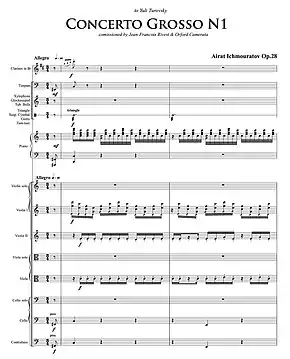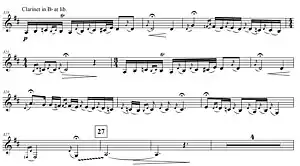Concerto Grosso N1 (Ichmouratov)
Airat Ichmouratov's Concerto Grosso N1, Op. 28, was composed in 2011. It was commissioned and premiered on 15 July 2011 by French - Canadian conductor Jean-François Rivest and Orford Camerata at Orford Art's Centre, Orford, Canada.[1] Ichmouratov himself was performing solo clarinet part as well on the recording of Concerto Grosso N1, that was released on Chandos in 2019.[2]
| Concerto Grosso N1 Op.28 | |
|---|---|
| by Airat Ichmouratov | |
 the first page of the conductor's score of Concerto Grosso N1 Op.28 by Airat Ichmouratov | |
| Opus | 28 |
| Composed | 2011 |
| Dedication | Yuli Turovsky |
| Performed | 15 July 2011 |
| Duration | about 21 minutes |
| Movements | three, without pause |
| Scoring | solo violin, solo viola, solo cello, solo clarinet, solo piano, Strings with timpani and percussion |
Dedication
Concerto Grosso N1 is dedicated to renowned Soviet-born Canadian cellist, conductor and music educator[3][4][5] Yuli Turovsky, whom Ichmouratov considered a mentor[6] and with whom collaborated on multiple occasions. In 2004 Turovsky invited Ichmouratov's klezmer band Kleztory to record CD with I Musici de Montreal chamber orchestra (Chandos Records).[7][8] Ichmouratov's "Fantastic Dances" for clarinet, cello and piano with Strings and percussion were commissioned and recorded by Yuli Turovsky & I Musici de Montreal.[9][10] The work was premiered in Pollack Hall on December 20, 2007.[10] In 2011, replacing Yuli Turovsky at short notice, Ichmouratov conducted I Musici de Montréal Chamber Orchestra on tour in USA,[11] Brazil[12] and Peru.[13]
Analysis
The work comprises three movements which performed without pause:
- Allegro - Poco meno mosso - Tempo I - Poco meno mosso
- Adagio - Con molta espressione, doloroso - Poco meno mosso
- Allegro con brio - Poco a poco crescendo - Poco più mosso, frenetico
A typical performance of the work lasts around 21 minutes.[9]

Klezmer influence
Ichmouratov, who has vast experience in klezmer music[6] (after being for more than 20 years a clarinetist of award-winning klezmer band Kleztory) often integrates klezmer folk music in his classical compositions,[14][6] as well he composed and recorded with Kleztory multiple works for klezmer band in traditional klezmer style.[15][16]

We can see the presence of klezmer influences in Concerto Grosso N1 as well. In the latter part of the first movement we can hear a melismatic clarinet doina emerges as a notable musical element. Its opening phrase, assumes a pivotal role in the composition, serving as the foundational musical cell from which Ichmouratov crafts the entire concerto. The doina's origins can be traced back to Romanian folk music traditions, but now firmly rooted in the klezmer style of music.[17] In the central Adagio movement, a transformation unfolds as the solo cello takes hold of the ascending motif. This motif, while bearing a Jewish modality, is a composer's creation. It resounds three times through the movement, each iteration deepening the emotional resonance. The clarinet then takes center stage, imbuing the motif with a full-throated lament, marked by the expressive directive "doloroso," signifying profound sadness. The concluding movement's central theme, a direct descendent of the broad, the second theme encountered in the opening movement, is introduced by the solo violin. This theme is subsequently echoed by the viola and, in short order, taken up by the entire orchestra. Against the backdrop of a resolute marching bass, angular triplet patterns accompany a violin melody, reminiscent of the freylekh style, and partially derived from the aforementioned triplets. This musical narrative escalates to a frenzied climax, characterized by the intense tones of the klezmer clarinet, which soon undergoes further development, eventually leading to the triumphant return of the exuberant central theme.[18][2]
Instrumentation
Concerto Grosso N1 is scored for solo violin, solo viola, solo cello, solo clarinet, solo piano, Strings with timpani and percussion (performed by 1 player), which consist: triangle, glockenspiel, tam-tam, guiro, tubular bells and suspended cymbal.[19]

Critical reception
The recording of Concerto Grosso N1 gained average-to-positive reviews. Jeremy Pound of BBC Music Magazine wrote: "Filmic, feisty, flamboyant and, admittedly, occasionally a little froth, Ichmouratov’s orchestral music is rarely dull. It benefits here from characterful performances".[20] Carlos Maria Solare of The Strad wrote: "The first movement of Ichmouratov’s Concerto grosso no.1 could be a rewrite of its opposite number in Prokofiev’s ‘Classical’ Symphony, albeit with a more heart-on-sleeve lyrical subject than the older composer might have countenanced".[21] Ateş Orga of ClassicalSource.com wrote: "Enviable confidence, facility and rhythmic tension inform the First Concerto Grosso".[22] David Guttman of Gramophone wrote: "The Concerto grosso No 1, Op 28, is vaguely neo-Baroque fare, fusing Russian and Jewish elements".[23]
References
- "Regional Calendar" (PDF). La Scene Musicale. 16: 31. July 2011. Retrieved 23 September 2023.
- "Ichmouratov: Orchestral Works". www.chandos.net. Retrieved 23 September 2023.
- Kaptainis, Arthur (15 January 2013). "Turovsky founded I Musici de Montréal". The Gazette (Montreal). Retrieved 16 January 2013.
- "Montreal cellist Yuli Turovsky dies at 73". CBC News. 16 January 2013. Retrieved 16 January 2013.
- Turbide, Nadia. "Yuli Turovsky". The Canadian Encyclopedia. Archived from the original on August 22, 2012. Retrieved 16 January 2013.
- Solomon, Heather (9 March 2016). "Klezmer band enlivens McGill Chamber Orchestra concert". The Canadian Jewish News. Retrieved 23 September 2023.
- Turbide, Nadia (28 June 2011). "I Musici de Montréal". www.thecanadianencyclopedia.ca. Retrieved 23 September 2023.
- "Klezmer: Jewish Music - CHSA 5027". www.chandos.net. March 2004. Retrieved 23 September 2023.
- "Shostakovich, Weinberg, Ichmouratov". outhere-music.com. Retrieved 23 September 2023.
- Foley, Daniel. "Shostakovich; Weinberg; Ichmouratov I Musici de Montreal; Yuli Turovsky Analekta AN 2 9899". www.thewholenote.com. Retrieved 23 September 2023.
- Timothy Mcdonald, Special to The Star (8 April 2011). "Review – I Musici di Montréal presented by the Harriman-Jewell Series". Kansas ,USA: Kansas City Star. Archived from the original on 2016-08-08. Retrieved 2015-08-07.
- Clarissa Coli (21 August 2011). "Musical exchange (in Portuguese)". Rio de Janeiro: Diário do Vale. Archived from the original on 2016-02-26. Retrieved 2015-08-07.
- "The Philharmonic Society of Lima: 104 AUGUST MONTH ANNIVERSARY (in Spanish)". Lima , Peru: sociedadfilarmonica.com.pe. 5 August 2011. Archived from the original on 2016-03-04. Retrieved 2015-08-07.
- Barber, Stephen. "Klezmer dreams". www.musicweb-international.com. Retrieved 23 September 2023.
- Thomas, Philip. "Kleztory: Momentum". folkradio.co.uk. Retrieved 23 September 2023.
- Blackburn, Roger. "Klezmer – Première Recordings". www.musicweb-international.com. Retrieved 23 September 2023.
- "Doina - Genre". musicbrainz.org. Retrieved 23 September 2023.
- Arloff, Steve. "Premiere recordings CHAN20141". www.musicweb-international.com. Retrieved 23 September 2023.
- "Ichmouratov, Airat : Concerto grosso No.1, op.28". daniels-orchestral.com. Retrieved 23 September 2023.
- BBC Music Magazine – Brief Notes section, October 2019”. Retrieved 8 May 2020
- The Strad – Elvira Misbakhova: Ichmouratov”. Retrieved 8 May 2020
- ClassicalSource.com – Airat Ichmouratov – Letter from an Unknown Woman [Chandos]” Retrieved 8 May 2020
- Gramophone, Ichmouratov – Letter From an Unknown Woman. Retrieved 8 May 2020
External links
- Airat Ichmouratov -Official website
- Canadian Music Centre
- complete recording of Concerto Grosso N1 Op.28 Belarusian State Chamber Orchestra Conductor: Evgeny Bushkov – Chandos, August 2019 (21:10)